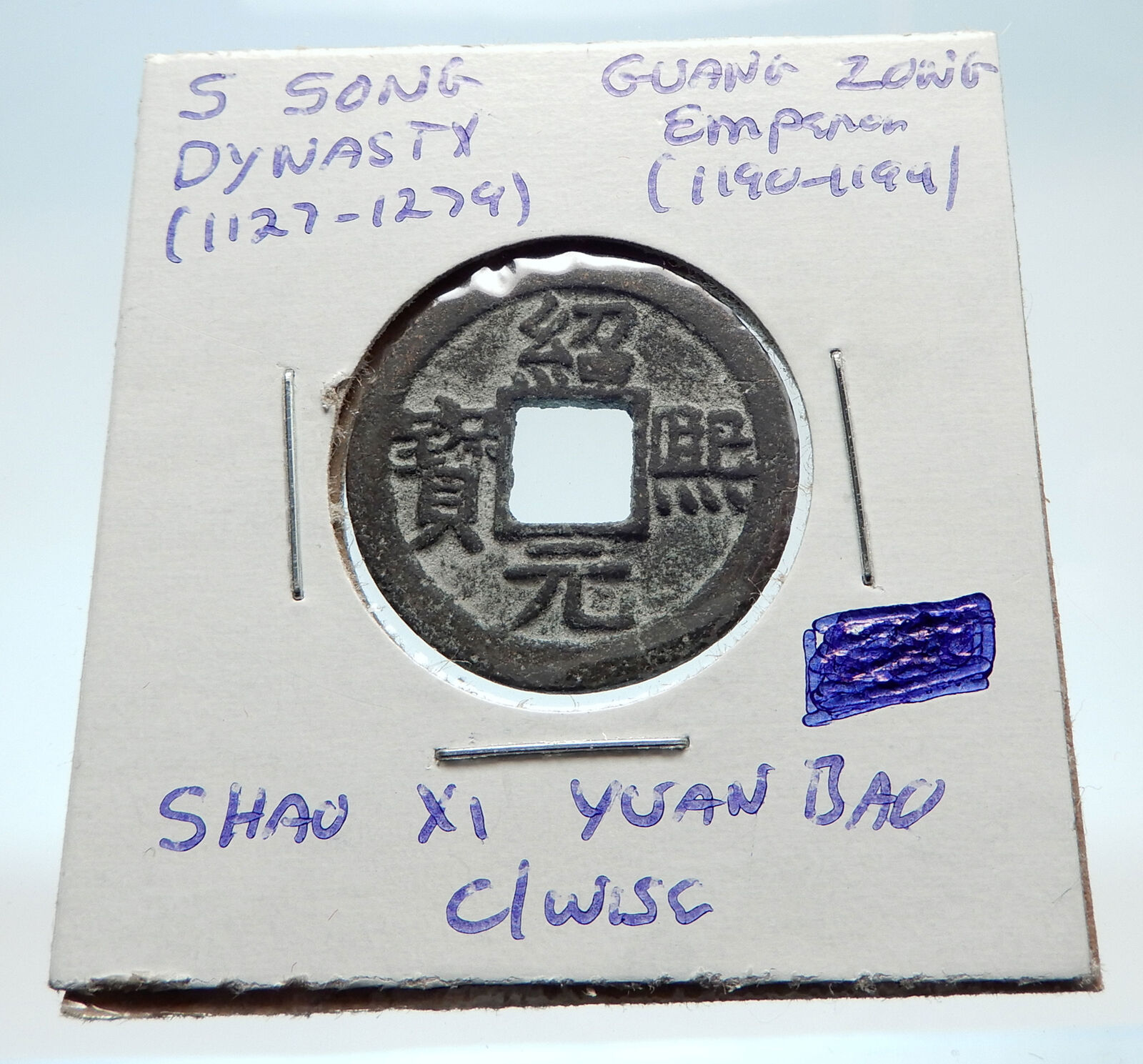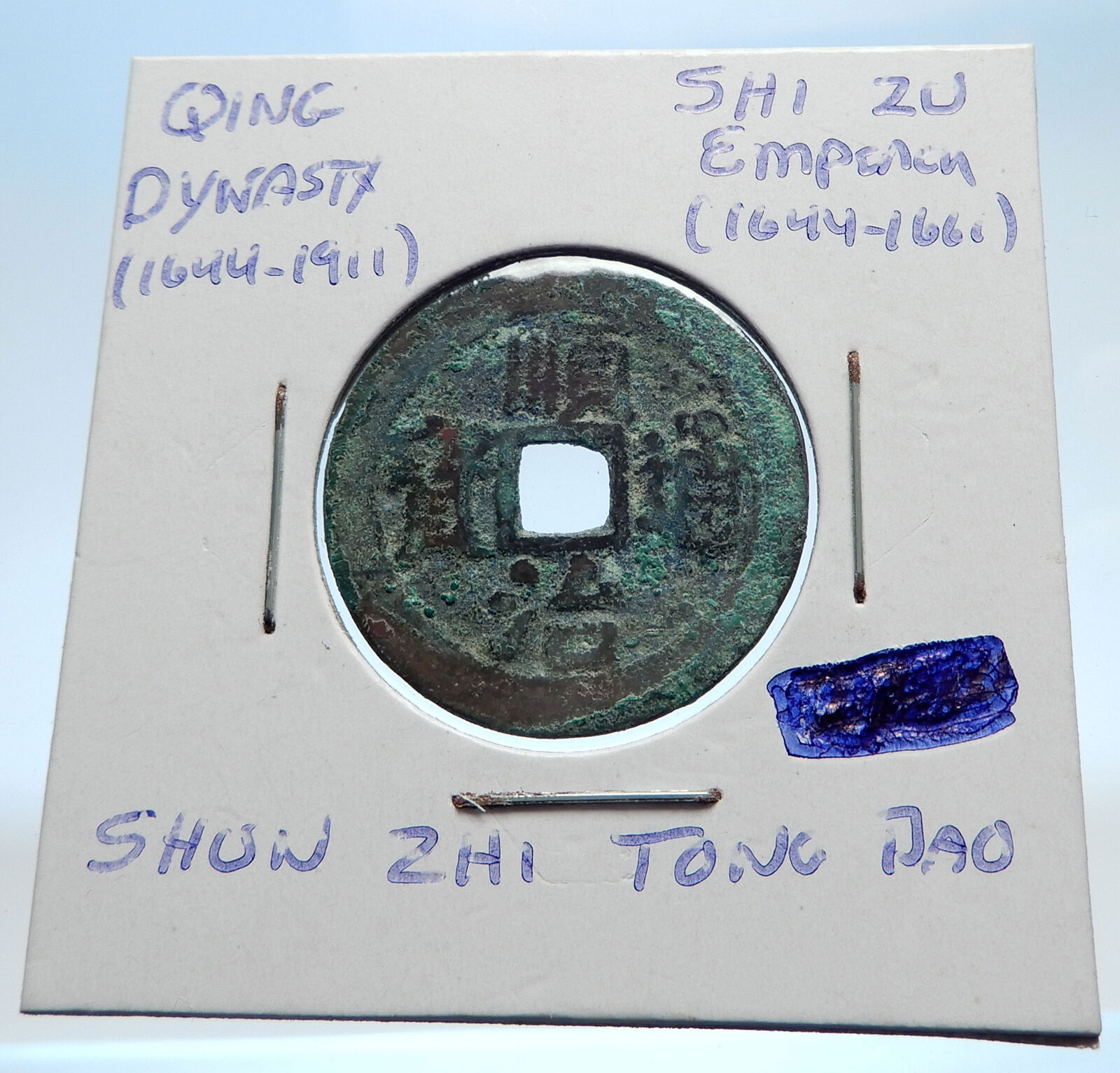|
Ancient
China – North Yuan Dynasty
Toghon Temur – Emperor: 1333-1368 AD
Bronze 10 Cash Token 41mm (21.63 grams), Struck 1358 AD
Reference: H# 19.117
Chinese Symbols.
Obv: Zhi Zheng Tong Bao
Rev: Seu for Wu Xu (1358) Dot and shi (10) below.
You are bidding on the exact item pictured, provided with a Certificate of Authenticity and Lifetime Guarantee of Authenticity.
 Toghon Temür (Mongolian: Тогоонтөмөр, Togoontömör; Chinese: 妥懽貼睦爾; pinyin: Tuǒhuāntiēmù’ěr; 25 May 1320 – 23 May 1370), also known by his temple name as the Emperor Huizong of Yuan (Chinese: 元惠宗) bestowed by the Northern Yuan dynasty and by his posthumous name as the Emperor Shun of Yuan (Chinese: 元順帝) bestowed by the Ming dynasty, was the last emperor of the Yuan dynasty and later the first emperor of the Northern Yuan dynasty. Apart from Emperor of China, he is also considered the last Khagan of the Mongol Empire. He was a son of Kusala (Emperor Mingzong). Toghon Temür (Mongolian: Тогоонтөмөр, Togoontömör; Chinese: 妥懽貼睦爾; pinyin: Tuǒhuāntiēmù’ěr; 25 May 1320 – 23 May 1370), also known by his temple name as the Emperor Huizong of Yuan (Chinese: 元惠宗) bestowed by the Northern Yuan dynasty and by his posthumous name as the Emperor Shun of Yuan (Chinese: 元順帝) bestowed by the Ming dynasty, was the last emperor of the Yuan dynasty and later the first emperor of the Northern Yuan dynasty. Apart from Emperor of China, he is also considered the last Khagan of the Mongol Empire. He was a son of Kusala (Emperor Mingzong).
During the last years of his reign, the Yuan dynasty was overthrown by the Red Turban Rebellion, which established the Ming dynasty, although the Yuan court under his rule remained in control of northern China and the Mongolian Plateau. The remnant Yuan regime is known as the Northern Yuan in historiography.
Emperor Huizong was a Buddhist student of the Karmapas (heads of the Karma Kagyu school of Tibetan Buddhism) and is considered a previous incarnation of the Tai Situpas. He also notably invited the Jonang savant Dölpopa Shérab Gyeltsen to teach him, but was rebuffed.
With the dismissal of Bayan, Toqto’a seized the power of the court. His first administration clearly exhibited fresh new spirit. The young leader was quick to distinguish his regime as something wholly different from Bayan’s. A new Chinese era name, Zhizheng (Chinese: 至正), was decreed to show this. Bayan’s purges were called off. Many of the great Chinese literati came back to the capital from voluntary retirement or from administrative exile and the imperial examination system was restored.
Toqto’a also gave a few early signs of a new and positive direction in central government. One of his successful projects was to finish the long-stalled official histories of the Liao, Jin and Song dynasties, which were eventually completed in 1345.
Toqto’a resigned his office with the approval of Toghon Temür in June 1344, which marked the end of his first administration. The several short-lived administrations that followed from 1344 and 1349 would develop an agenda very different from Toqto’a’s. In 1347, the emperor forced Toqto’a into Gansu with assistance from former officers of Kuśala and Yesün Temür.
In 1349, Toghon Temür recalled Toqto’a, which began Toqto’a’s second and very different administration.
Since the late 1340s, people in the countryside suffered from frequent natural disasters, droughts, floods, and ensuing famines. The lack of effective government policy led to a loss of support from the people. Illicit salt dealers who were disaffected by the government’s salt monopoly raised a rebellion in 1348, triggering many revolts around the empire. Among them was the Red Turban Rebellion, which started in 1351 and grew into a nationwide turmoil.
In 1354, when Toqto’a led a large army to crush the Red Turban rebels, Toghon Temür suddenly dismissed him for fear of betrayal. This resulted in the restoration of Toghon Temür’s power but also a rapid weakening of the central government. Thus he had no choice but to rely on the forces of local warlords.
Toghon Temür gradually lost interest in politics and ceased to intervene in political struggles. His son Biligtü Khan, who became Crown Prince in 1353, attempted to seize power and came into conflict with Toghon Temür’s aides, who dominated politics instead of the khan. During this time power was increasingly exercised by Lady Ki. Chief Empress Lady Ki and his minister persuaded Biligtü Khan to overthrow the latter. Toghon Temür was unable to conciliate the dispute but executed the minister. In 1364 the Shanxi-based warlord Bolad Temür occupied Khanbaliq and expelled the Crown Prince from the winter base. In alliance with the Henan-based warlord Köke Temür, Biligtü Khan defeated Bolad Temür in the next year. This internal struggle resulted in further weakening of the political and military power of the central government. In 1365, Toghon Temür finally promoted his much beloved Lady Ki to First Empress and announced that his son by her would be the first in the line of succession.
During the Yuan dynasty, one of Confucius’ descendants, who was one of the Duke Yansheng Kong Huan’s 孔浣 sons, named Kong Shao 孔紹, moved from China to Goryeo era Korea and established a branch of the family there called the Gong clan of Qufu after marrying a Korean woman (Jo Jin-gyeong’s 曹晉慶 daughter) during Toghon Temür’s rule. (Also see 曲阜孔氏 (朝鲜半岛) and 곡부 공씨)
Cash was a type of coin of China and East Asia, used from the 4th century BC until the 20th century AD. Originally cast during the Warring States period, these coins continued to be used for the entirety of Imperial China as well as under Mongol, and Manchu rule. The last Chinese cash coins were cast in the first year of the Republic of China. Generally most cash coins were made from copper or bronze alloys, with iron, lead, and zinc coins occasionally used less often throughout Chinese history. Rare silver and gold cash coins were also produced. During most of their production, cash coins were cast but, during the late Qing dynasty, machine-struck cash coins began to be made. As the cash coins produced over Chinese history were similar, thousand year old cash coins produced during the Northern Song dynasty continued to circulate as valid currency well into the early twentieth century.
In the modern era, these coins are considered to be Chinese “good luck coins”; they are hung on strings and round the necks of children, or over the beds of sick people. They hold a place in various superstitions, as well as Traditional Chinese medicine, and Feng shui. Currencies based on the Chinese cash coins include the Japanese mon, Korean mun, Ryukyuan mon, and Vietnamese văn.
|




 Toghon Temür (Mongolian: Тогоонтөмөр, Togoontömör; Chinese: 妥懽貼睦爾; pinyin: Tuǒhuāntiēmù’ěr; 25 May 1320 – 23 May 1370), also known by his temple name as the Emperor Huizong of Yuan (Chinese: 元惠宗) bestowed by the Northern Yuan dynasty and by his posthumous name as the Emperor Shun of Yuan (Chinese: 元順帝) bestowed by the Ming dynasty, was the last emperor of the Yuan dynasty and later the first emperor of the Northern Yuan dynasty. Apart from Emperor of China, he is also considered the last Khagan of the Mongol Empire. He was a son of Kusala (Emperor Mingzong).
Toghon Temür (Mongolian: Тогоонтөмөр, Togoontömör; Chinese: 妥懽貼睦爾; pinyin: Tuǒhuāntiēmù’ěr; 25 May 1320 – 23 May 1370), also known by his temple name as the Emperor Huizong of Yuan (Chinese: 元惠宗) bestowed by the Northern Yuan dynasty and by his posthumous name as the Emperor Shun of Yuan (Chinese: 元順帝) bestowed by the Ming dynasty, was the last emperor of the Yuan dynasty and later the first emperor of the Northern Yuan dynasty. Apart from Emperor of China, he is also considered the last Khagan of the Mongol Empire. He was a son of Kusala (Emperor Mingzong).




